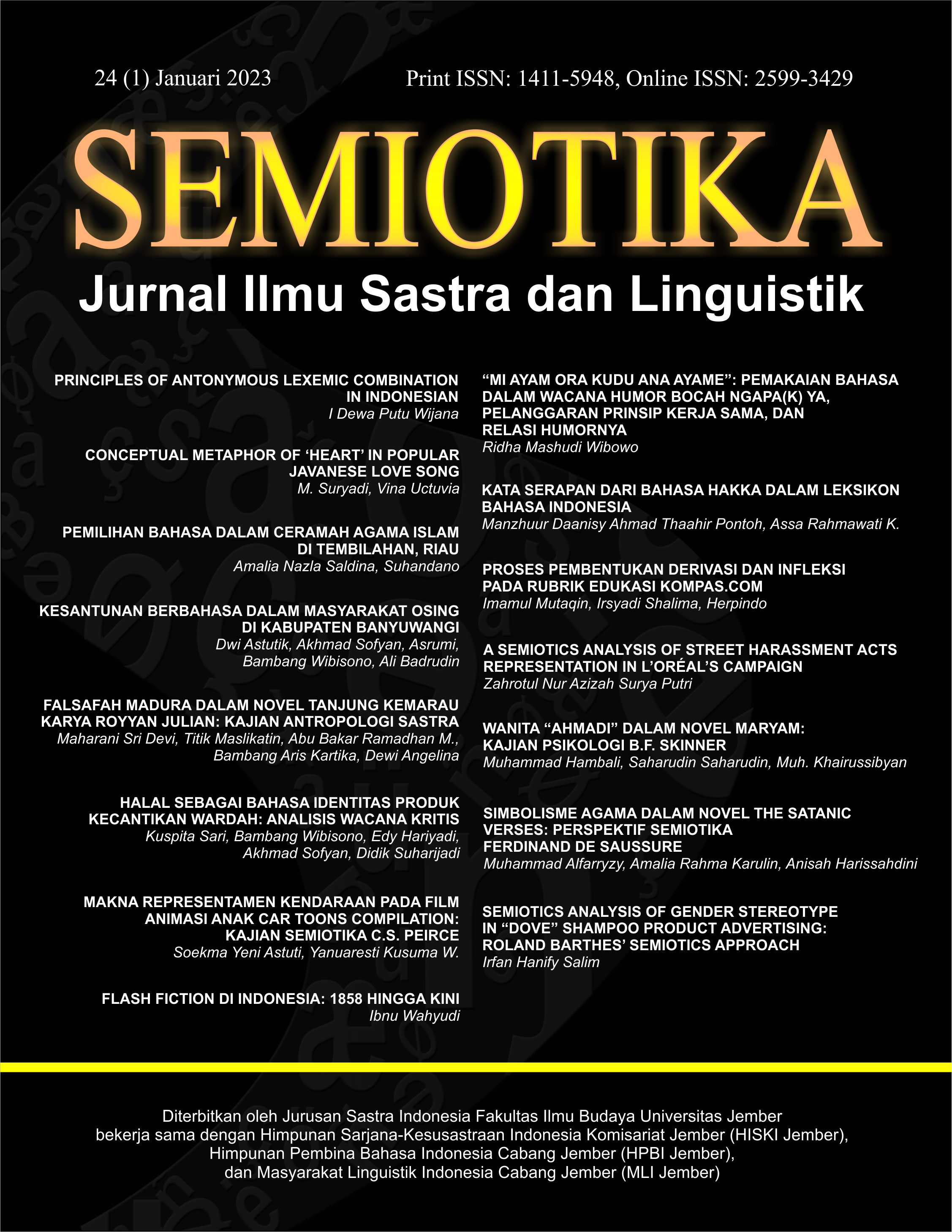HALAL SEBAGAI BAHASA IDENTITAS PRODUK KECANTIKAN WARDAH: ANALISIS WACANA KRITIS
Keywords:
critical discourse analysis, halal advertising, the commodification of religion, Wardah cosmeticAbstract
In Indonesia, the trend of products using religious commodities filled the economic market, which used "halal" diction. This study aims to answer several questions. Firstly how is the halal commodification process produced related to Wardah products? Second, how is the halal commodification process produced related to Wardah advertisements? The last is about the halal commodification process in which discourse and a "power" battle space occur. Systematization reproduced the specific knowledge. In contrast, variants are presented in specific ways. The research approach used is descriptive qualitative research. Data collection activities were carried out using the listening method and recording techniques to transcribe the data obtained. The data analysis process is carried out using the discourse theory proposed by Michel Foucault, using the genealogical method. The study results indicate that in the process of producing halal commodification related to halal products, all discourses that move in the Wardah production area are opposed to everything outside of Wardah. Besides, the openness of the power system process shows that these relations do not always dominate each other but instead play a role in strengthening the power of the halal products produced by Wardah. The results showed that when halal advertisements produced by Wardah were distributed to consumers (the public), they experienced several responses. Some people support halal advertisements, people reject halal advertisements, and neutral society towards halal advertising. This community response becomes data that is processed, selected, and sorted for reconstruction, intending to strengthen further the existence of Wardah formed by halal advertising. The relationship between Wardah, which produces the halal advertisements with other subjects outside, is interpreted as a space for the process of power to take place.
Downloads
References
Indofoodâ€. Jurnal Etikonomi, 6 (2):171—188.
Baudrillard, J. 2015. Masyarakat Konsumen. Terj. Malindo. Bantul: Kreasi Wacana.
Cahyani, I. & Baskoro, B.R.S. 2018. “Analisis Wacana Kritis Iklan Produk Kecantikan dalam
Majalah Vogue Usâ€. Tesis. Yogyakarta: Prodi Magister Linguitik, Fakultas Ilmu Budaya,
Universitas Gadjah Mada. Perpustakaan UGM. [Online] 2018. (Cited: Juni 03, 2020.)
http://etd.repository.ugm.ac.id/penelitian/detail/157727
Dahlan, A.A. 1996. Ensiklopedi Hukum Islam. Jakarta: Ikhtiar Baru van Hoeve.
Efendi, I. 2016. “Kecantikan Khas Wanita Berjilbab dalam Iklan Televisi (Analisis Semiotika
terhadap Iklan Kosmetik Wardah Versi Kisah di Balik Cantik)â€. Skripsi. Makassar:
Jurusan Jurnalistik, Fakultas Dakwah dan Komunikasi, UIN Alauddin Makassar.
Eriyanto. 2001. Analisis Wacana Pengantar Analisis Teks Media. Yogyakarta: LKiS.
Foucault, M. 2002. Power/Knowledge Wacana kuasa/Pengetahuan. Terj. Yudi Santoso.
Yogyakarta: Bentang Budaya.
Foucault, M. 2008. Ingin Tahu Sejarah Seksualitas. Terj. Rahayu S. Hidayat. Jakarta: Yayasan
Obor Indonesia.
Furchran, A. 1998. Pengantar Metode Penelitian Kualitatif. Surabaya: PUN.
Hariyadi, E. 2019. “Tren Komodifikasi Diksi dan Simbol Agama dalam Iklan Televisi di
Indonesiaâ€. Dalam Anoegrajekti, dkk. (ed.) Teori Kritis dan 95 Metodologi, Dinamika
Bahasa, Sastra, dan Budaya. Yogyakarta: Penerbit Kepel Press.
Kansong, U. 2020. “Sajak Kofeâ€. E-Paper Media Indonesia. [Online] Media Indonesia, April
01, 2020. [Cited: November 2021, 2021.]
https://mediaindonesia.com/podiums/detail_podiums/1791-panopticoncovid-19.
Kholifah, F.S. 2016. “Iklan Layanan Kesehatan Masyarakat Berbahasa Indonesia: Analisis
Wacana Kritisâ€. Skripsi. Jember: Prodi Pendidikan Bahasa dan Sastra Indonesia, Jurusan
Pendidikan Bahasa dan Seni, FKIP Universitas Jember. Diakses dari
http://repository.unej.ac.id
Kotler, P., Kartajaya, H. & Setiawan, I. 2019. Marketing 4.0 Bergerak dari Tradisional ke
Digital. Jakarta: Gramedia Pustaka Utama.
LPPOM MUI. 2021. “Kriteria Sistem Jaminan Halal dalam HAS23000â€. halalmui.org. [Online]
LPPOM MUI, Oktober 01, 2021. [Cited: September 09, 2021.]
https://www.halalmui.org/mui14/main/page/kriteria-sistemjaminan-halaldalamhas23000.
Lukitaningsih, A. 2013. “Iklan yang Efektif sebagai Strategi Komunikasi Pemasaranâ€. Jurnal
Ekonomi dan Kewirausahaan, 13 (2):116—129.
Maulida, L. & Witro, D. 2022. “Komodifikasi Simbol-Simbol Agama di Kalangan Kelas
Menengah Muslim di Indonesiaâ€. Jurnal Penelitian Mahasiswa Ilmu Sosial, Ekonomi,
dan Bisnis Islam (SOSEBI), 2 (2):13—21.
Moleong, L. J. 2016. Metodologi Penelitian Kualitatif. Bandung: Remaja Rosdakarya.
Muslimah, S. 2012. “Label Halal pada Produk Pangan dalam Perspektif Perlindungan
Konsumen Muslimâ€. Jurnal Yustisia, 1 (2):25—32.
Nasution, Zahri. 2007. “Bahasa sebagai Alat Komunikasi Politik dalam Rangka
Mempertahankan Kekuasaanâ€. Sodality: Jurnal Transdisiplin Sosiologi dan Ekologi
Manusia, 12 (3):445—464.
Pakuna, H.B. 2014. “Fenomena Komunitas Berjilbab: Antara Ketaatan dan Fashionâ€. Jurnal
Farabi, 11 (2):34—41.
Pranowo, Y. 2017. “Genealogi Moral Menurut Foucault dan Nietzsche: Beberapa Catatanâ€.
Melintas 33.1.2017.
Widyatama, R. 2005. Pengantar Periklanan. Jakarta Pusat: Buana Pustaka Indonesia.
Wikipedia.org. 2022. “Wardahâ€. https://id.wikipedia.org/wiki/Wardah. (Diakses 12 Mei 2022).
Downloads
Published
Issue
Section
License
SEMIOTIKA has CC-BY-SA or an equivalent license as the optimal license for the publication, distribution, use, and reuse of scholarly work. Authors who publish with this journal retain copyright and grant the journal right of first publication with the work simultaneously licensed under a Creative Commons Attribution-ShareAlike 4.0 International License that allows others to share the work with an acknowledgment of the work's authorship and initial publication in this journal.
Attribution-ShareAlike
CC BY-SA


